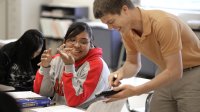Guiding Students to Discover the Beauty of Math
Simple strategies and a positive environment can spark students’ curiosity and encourage them to explore how math touches our lives.
Your content has been saved!
Go to My Saved Content.My passion for mathematics started in middle school, where my teacher would make complex concepts look very easy. Her classroom would always be engaging, filled with high energy and enthusiasm. It was inspiring to see any complex idea made simpler by connecting it to learning outcomes, pattern recognition, and real-life situations.
I have always started my new academic year with a big question, “How do I make my math classroom fun and engaging?” focusing on my three Rs: rigor, relevance, and relationship. Creating a positive environment where my students feel safe, open, and encouraged to explore problem-solving is essential. With simple strategies in place, students can be encouraged to let go of their fear of math, be curious, and explore the beauty in math.
Rigor: Transforming From Boring to Engaging
The ANet Achievement Network asserts that under the Common Core, “achieving rigor requires us to teach math in a way that balances students’ conceptual understanding, their procedural skill and fluency, and their ability to apply what they know and can do to real-world, problem-solving situations.” Taking knowledge to apply practicing skills shows rigor in my classroom. Challenging students’ thinking in new and exciting ways using hands-on activities and experiential-based projects transforms a boring classroom into an engaging one.
Technological tools are an easy way to make a classroom interactive and engaging. For example, students enjoy PhET simulations, which use gamification to teach several mathematical concepts. Padlet creates walls that can make discussions come alive and thinking visible! Pear Deck helps me engage and interact with students to collaborate and work on their aha moments. I use the collaborative strategy think-pair-share in my classrooms to have practical discussions and push my students to think critically. I also create stations for students to work together on different related topics to build their skills and deepen their understanding.
Relevance: Transforming From Standard to Conceptual Based
I use big ideas to drive the classroom instruction and let students ask why to connect the standard-based approach to a conceptual bigger picture. Students use graphic organizers such as the Frayer Model, concept mapping, or a T-chart to help in visualizing concepts to make a note of patterns and underlying themes. The scholastic approach through asking questions and developing curiosity is a big part of learning in my class. Students grow by making mistakes and learning from them. As an educator, I need to create a safe environment for my students to make mistakes and create learning opportunities in problem-solving. My mentor used to call this “failing forward” by encouraging a mindset centered on turning mistakes into stepping-stones for success.
I set high expectations for my students and want them to become skilled critical thinkers who believe they can do the math! Scaffolding is an excellent way to offer support to the individual needs of the students as they learn and develop a new skill. Using multiple strategies to solve a given problem helps students use the most efficient approach to achieve their learning goals. Reasoning through a problem and asking the right questions promotes creative problem-solving skills that show them multiple ways to find an answer. Students always have opportunities to talk about different approaches and compare them while solving a problem in my class.
Relationship: Transforming From Disconnected to Connected
Students are excited to learn when they own their learning by exploring the content and making connections. Taking a simple problem and solving it through peer learning helps students develop a long-lasting understanding. The students also develop higher self-efficacy and confidence.
I begin my lesson planning by focusing on what my students already know and connecting that to the new learning. Building on prior knowledge and the relationships between concepts helps students keep their interest and construct new knowledge. Whether we are looking at the beauty in nature with Fibonacci sequences or discussing shopping and learning about taxes and discounts, connecting my students to real-life situations with math around us helps make learning fun and relevant. Moving from knowledge to skill building by encouraging students to apply their learning through small projects gives black-and-white concepts real-world meaning and promotes creative thinking.
Students effectively learn when they are part of a learning community where they feel safe expressing their thinking and participating by sharing their ideas openly. I use relaxation tools to help create a positive environment that brings my students together, promoting excellence and developing their growth mindset. For example, I lead my students through simple breathing exercises to relieve anxiety before a quiz, affirmations to build confidence, and relaxation techniques to end the day to help my students come together as a community. As a result, students also develop greater interest in coming into the class, calm and confident in working together with an open mind!
Math is beautiful. I love sharing my passion for it with my students and showing them that math is central to solving real-life problems, whether their interests are in fashion design, cosmetology, science, engineering, or culinary arts.
